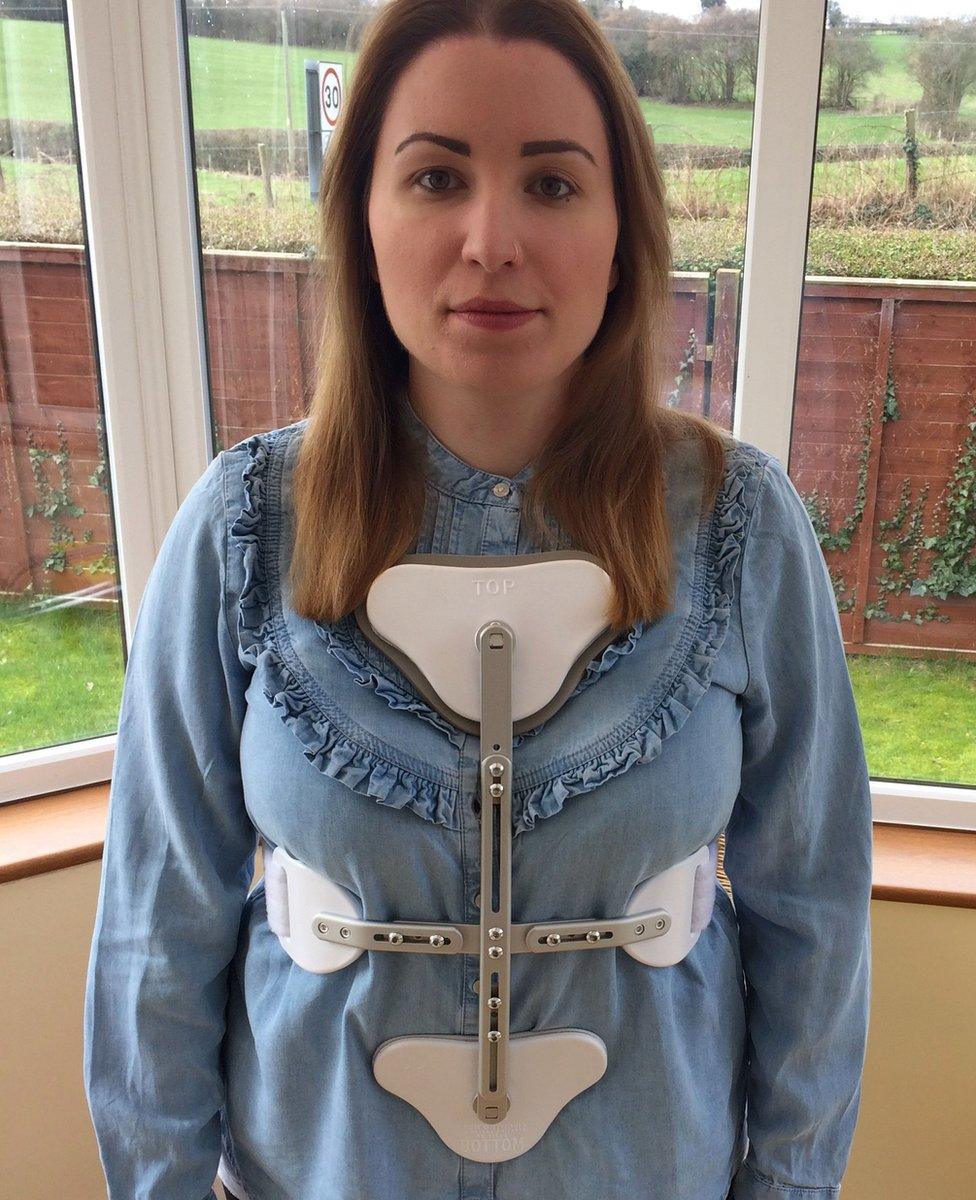Trampoline park emergency calls revealed
- Published
- comments
A student talks about how he broke his back at a trampoline park
Ambulances were called to trampoline parks in the UK more than 300 times in a year, figures obtained by BBC 5 live's Daily programme show.
One park, Flip Out Stoke, called out an ambulance more than once a week on average. But Jump Lanes, Londonderry, had no callouts across the 12 months.
Statistics from a Freedom of Information request show callouts made by 30 parks in 12 months to April 2016.
More than 140 UK trampoline parks have opened since the first in 2014.
One park in Chester is investigating after three people broke vertebrae in their backs on the same day.
Operators insist the number of injuries is very small compared to the total number of users.
Thirteen ambulance trusts across the UK confirmed that, between April 2015 and April 2016, 30 parks required 315 ambulance call outs.
The figures showed:
Flip Out Stoke had the highest rate of call outs amongst the trusts
Paramedics attended 17 times in 109 days - once every six days - following its opening in December 2015
Oxygen Freejumping in Southampton, which had 200,000 jumpers in the last year, has the next highest callout rate: 13 call outs in 114 days - one every 9 days
Air Hop in Guildford, which has about 300,000 jumpers annually, had 39 call outs - an average of one every nine days (assuming it was open for 365 days).
Flip Out Stoke is a franchise of the same company behind Flip Out Chester, where an investigation into the injuries is under way.

Sarah McManus wears a back brace after being injured at Flip Out in Chester
Flip Out has closed the Jump Tower section of the Chester park.
It said the call out rates should be taken in the context of the number of users - 200,000 visitors have been to the Chester site since it opened in December 2016.
Another of the company's franchises, Flip Out Portsmouth, had a lower call out rate, with paramedics attending eight times in its first 106 days - an average of once every 13 days.
Broken back
A broken limb was the top injury suspected [14 of the 65 call outs] with broken legs the most common.
The other most common suspected injuries were spinal, head, back and foot.
Student George Magraw, 21, was one of the three people who broke their back on the same day jumping from Flip Out Chester's 4m high 'Tower Jump'.
He told BBC Radio 5 Live: "I'd been jumping on the trampolines for ten minutes when I moved on to the Tower Jump.
"I jumped off the ledge just how I'd been told in the safety video but as soon as I landed I was in pain.

"I crawled out of the foam pit and stood up. I could definitely feel that the bone wasn't right.
"The staff gave me first aid and offered to ring an ambulance but my dad was only minutes away so he took me instead.
"When I arrived at A&E I was quickly put on a bed and taken for an X-Ray. It was then they told me I'd broken my back."
'Dangerous place to be'
George's transfer to a specialist unit in Walton was delayed because the centre was already dealing with another customer injured on the jump.
His mother, Janet Magraw, is now warning parents to understand the risks: "I always thought that going to a trampoline park, it's a soft landing and everything's okay.
"I've since heard from lots of medical staff that that's not the case - it's quite a dangerous place to be.
"I personally wouldn't recommend anybody going to them. At half term it was sickening me that there was a big queue of little kids going into that place.
"As a mum, you just really feel it could be life-changing."
'Excellent record'
A spokesman for Flip Out Chester said since its December 2016 opening, around 200,000 people had visited and it had "an excellent safety record".
"We welcome feedback from our customers and we are investigating these claims to establish exactly what happened," he said.
'More speed'
CEO at Oxygen, David Stalker said it got the design of their park wrong when it first opened.
He said: "The trend was towards opening up spaces, rather than zoning the trampolines into smaller areas as we do now.
"The more open space you have, the more speed you can gain. The result was more injuries."
He added: "We've now altered the designs for future parks and changed the layout at Southampton."
Sporting injuries
One of the smallest parks, Jump Lanes in Londonderry, which has around 25,000 visitors a year, had the fewest call outs - none in 12 months.
Air Hop in Guildford is one of the largest parks. Its smaller site in Bristol saw fewer callouts with eight in 193 days - one every 24 days.
Spokesman Chris Gilmour said trampoline parks should be viewed in context of other activities that carry risk.
He said: "Hospitals will tell you that, yes, they get injuries from trampoline parks but they see worse from people playing football or rugby.
"When you look at the percentage of customers who are injured it's in the hundredths of a percent."
The BSI [British Standards Institution] published standards for trampoline parks, at the request of the industry, earlier this month.
They include minimum specifications for the number of stewards and rules on specific safety features.
Peter Brown, chair of the UK's largest industry body the International Association of Trampoline Parks UK [IATP] said many parks were already up to standard.
New parks would have to comply and inspections would begin in August.
"Any issues we find will have to be put right within a reasonable timeframe, depending on how significant it is. In the most severe cases we will insist attractions are closed until fixed."
Bouncing craze
The number of parks in the UK has increased sharply since the first one opened in May 2014 - inspired by a craze that started in 2004 in the United States.
Thirty-seven had opened by November 2015, rising to 110 by November 2016, and 144 in early March 2017.
By Easter 2017, the IATP estimates there will be 150 parks in operation across the UK, with at least 15m visitors per year.
- Published13 March 2017

- Published30 November 2016

- Published16 December 2016
